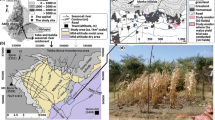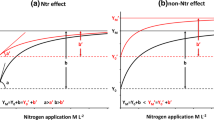Abstract
Sluijsmans and Kolenbrander developed a simple model to describe the availability of animal manure, assuming a readily available, an easily decomposable and a slowly decomposable N fraction. We tested this model on data from an experiment in which farmyard manure had been applied for eleven successive years to silage maize [Zea mays L.] grown on a light sandy soil. The residual effects of this FYM were then measured by growing Italian ryegrass [Lolium multiflorum Lamk.] in the 12th year. The measured uptake of N by the grass of the FYM residues was then compared with the computed values. The measured amounts of N taken up agreed fairly well with the calculated amounts for applications of 50 and 100 t FYM per ha per year.
If the rates of manure application are adjusted to crop requirement, the model shows that the potential, long-term release of N from the residual N fraction of FYM will not exceed 20 kg N per ha. For cattle slurry with a smaller residual fraction, the release will be at most 10% of the total annual N application.
Similar content being viewed by others
References
Dilz K and Brak A (1976) Dierlijke mest en maisteelt. Stikstof 95/96: 393–400
Kürten PW and Saalbach E (1961) Ueber den Einfluss von Stallmist auf die Wirkung der Stickstoffdüngung. Z Acker- Pflanzenbau 114: 23–31
Prins WH, Dilz K and Neeteson JJ (1988) Current recommendations for nitrogen fertilisation within the EEC in relation to nitrate leaching. Fertiliser Society Proc 276, 27 pp
Schröder J and Dilz K (1987) Cattle slurry and farmyard manure as fertilizers for forage maize. In: Meer HG van der, Unwin RJ, Dijk TA van and Ennik GC (eds) Animal manure on grassland and fodder crops. Fertilizer or Waste? Developments in Plant and Soil Sciences 30: 137–156, Kluwer, Dordrecht
Sluijsmans CMJ and Kolenbrander GJ (1977) The significance of animal manure in soils. Proc Int Sem Soil Environ and Fert Manag in Intensive Agric, Tokyo, Japan, pp 403–411
Wolf J, Wit CT de and Keulen H van (1989) Modeling long-term crop response to fertilizer and soil nitrogen. I. The model. Plant and Soil 120: 11–22
Wolf J and Keulen H van (1989) Modeling long-term crop response to fertilizer and soil nitrogen. II. Comparison with field results. Plant and Soil 120: 23–38
Author information
Authors and Affiliations
Rights and permissions
About this article
Cite this article
Dilz, K., Postmus, J. & Prins, W.H. Residual effect of long-term applications of farmyard manure to silage maize. Fertilizer Research 26, 249–252 (1990). https://doi.org/10.1007/BF01048763
Issue Date:
DOI: https://doi.org/10.1007/BF01048763




